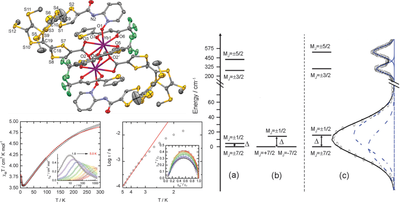Lanthanide luminescent materials
Correlation Magnetism/Luminescence.
This project concerned the study of multifunctional lanthanide complexes combining magnetic ‘SMM) and luminescent properties. The coexistence and even more the synergy of those properties open new perspectives in the field of molecular devices and molecular electronics. These two properties are intimately intricate and governed by the electronic structure of the central ion and more precisely by the crystal field splitting. In 2013, we reported the first luminescent Yb SMM complex. (Chem. Commun. 2013, 49, 615-617)
Low temperature (10-77K), high resolution solid state spectroscopy of lanthanide complexes in the crystal state enable to establish the energy diagram of its the fundamental and excited states.
A strong correlation between luminescence and magnetic properties has be demonstrated which can be further interpreted using modern quantum chemistry tools. (Account Chem. Res. 2015, 48, 2834−2842)

Collaborations:
Drs F. Pointillart, O. Cador, L. Ouahab, B. Le Guennic (Rennes) ANR SCOSIMLIGHT (2014-2016); Drs. G. Nocton (Ecole Polytechnique) ANR REDIVALAN (2016-2019); Pr. D. Luneau (Lyon); Dr. G. Pilet (Lyon)
Soft-Phosphors.
The lanthanide tris-dipicolinate complex [Ln(DAP)3]3- has been extensively studied for its luminescent properties. We have shown that the use of guanidinium counter ion enable the easy preparation of large size crystals containing less water molecule (Opt. Mater. 2008, 30, 1682-1688). Recently we developed 1) the preparation of co-crystal containing several lanthanide emiters to modulate the emission color 2) the tricky synthesis of luminescent core-shell materials (blinking crystals) and 3) the preparation of white-light emissing materials.

Collaborations.
Drs. C. Thieuleux, L. Veyre (C2P2 Lyon), Dr. G. Pilet (Lyon)
Ultrabright nanoparticles.
Ultrabright silica nanoparticles have been prepared either by doping (J. Mater. Chem. 2011, 21, 18613-18622) or by controlled grafting of the surface (Chem. Mater. 2014, 26, 1062−1073) with lanthanide complexes emitting either in the visible (Eu) or in the NIR (Yb) spectral range. The photophysical properties of these nano-materials have been studied and the surface heterogeneity has been characterized using an extended stretched exponential model to fit experimental lifetime decays. Single nano-particles have been successfully image by biphotonic microscopy.

Collaborations.
Pr. Coperet (ETH Zurich, Switzerland) ; Dr. A. Ibanez (Institu Neel, Grenoble) ; Dr. S. Brasselet (Institut Fresnel Marseille).



